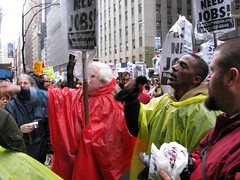
Demonstration organized by the Bail Out the People Movement (BOPM) outside Bank of America on April 3, 2009 in New York City. (Photo: Alan Pollock)
Originally uploaded by Pan-African News Wire File Photos
By Robin Harding in Washington
Last updated: November 16 2010 08:02
The US Federal Reserve has deployed two of its most senior officials to defend its new $600bn round of quantitative easing in rare on-the-record interviews that reveal the bank’s concern over domestic and international criticism of the policy.
Janet Yellen, Fed vice-chair, and William Dudley, president of the New York Fed, dismissed concerns that quantitative easing was aimed at weakening the dollar or that it could ignite inflation.
Mike Pence, chairman of the House Republican conference, on Monday said he planned to introduce a bill that would end the Fed’s dual mandate on unemployment and inflation and force it to concentrate solely on price rises.
A group of Republican economists have also written an open letter to Fed chairman Ben Bernanke saying that the “planned asset purchases risk currency debasement and inflation”. Separately, countries from Brazil to Germany have attacked the policy as a ploy to weaken the dollar.
Fears that the heavy opposition could prompt the Fed to stop its asset purchases short of $600bn led to heavy selling of Treasury bonds on Monday. The yield on 10-year US Treasury notes rose above 2.9 per cent, returning to the levels of early August, before the Fed’s latest round of easing was priced in.
The Fed now has two urgent tasks. First, it must restore market confidence that it will see its policy through, or else it risks losing all of the benefits of lower rates. Second, it needs to regain the initiative in the political debate, to ensure that it has the flexibility to buy more than $600bn if it judges it necessary.
Mr Dudley dismissed concerns that the Fed’s policy could lead to inflation, saying that the central bank has the tools to withdraw the additional stimulus if it needs to.
“We are very, very confident that those tools will be completely effective at keeping inflation in check,” Mr Dudley told the New York Times. “We are completely willing to use those tools, when the time comes, to prevent an inflation problem. Higher inflation is not a way out. It is not a solution.”
Ms Yellen also said the Fed was not trying to generate above-target inflation.
“I am not happy to see us caught up in a political debate. But Congress has assigned us tasks which we need to carry out as best we can. To fail to take action that is in our power that we, in our best judgment, believe to be helpful to the economy – that would be political,” she told the Wall Street Journal.
There will be a test of Congressional attitudes towards the Fed on Tuesday when Peter Diamond, nominated as a Fed governor, has his confirmation hearing in front of the Senate banking committee.
Both officials dismissed claims that the Fed’s action was aimed at weakening the dollar.
“We have no goal in terms of pushing the dollar up or down,” Mr Dudley said. “Our goal is to ease financial conditions and to stimulate a stronger economic expansion and more rapid employment growth.”
“The purpose of it is not to push down the dollar. This should not be regarded as some sort of chapter in a currency war,” said Ms Yellen.
Any decline in interest rates – which is the goal of the quantitative easing purchase programme – tends to weaken a country’s currency by making it more attractive to invest in another country where rates are higher.
Ms Yellen set out a gloomy economic outlook, saying she was “having a hard time seeing where really robust growth can come from”, and adding that the economy had “real downside risk”. Her outlook implies the Fed will need to complete its $600bn of asset purchases and possibly more.
The Fed’s statement on November 3 said that it would “employ its policy tools as necessary to support the economic recovery” – a signal that it is willing to go beyond $600bn if needed.
While there has been some stronger economic data in recent days, there has been nothing to suggest a fundamental change in the outlook for unemployment or inflation. The Fed is also unlikely to adjust the size of its asset purchase programme except in large increments of hundreds of billions of dollars.
Despite the market’s response, it is therefore still very likely that the Fed will buy all $600bn unless there is a much bigger change in the economic data.
Copyright The Financial Times Limited 2010. Print a single copy of this article for personal use. Contact us if you wish to print more to distribute to others.
No comments:
Post a Comment